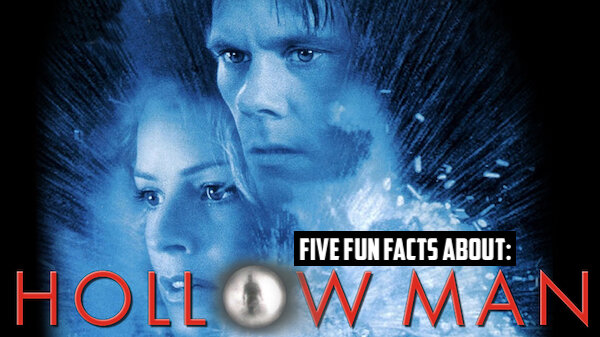Five Fun Facts About Hollow Man
Hollow Man was a mid-2000s sci-fi horror/thriller by Paul Verhoeven. After making 1997’s Starship Troopers, Verhoeven wanted to make a more "conventionally commercial blockbuster" for his next feature. That film would be Hollow Man, and while it definitely rings a bit hollow (especially when held against the rest of Verhoeven’s filmography), it’s not without its moments of intrigue. The film would even cause Verhoeven to leave America for the Netherlands, after nearly 20 years of working and living in the United States, where he’s remained ever since.
With recent release of Leigh Whannell’s terrific modernization of H. G. Wells’ beloved story The Invisible Man, we’ve revisited the less terrific modernization from Dutch filmmaker Paul Verhoeven, 2000’s Hollow Man, and are serving up five fun facts about the film and its production!
Kevin Bacon took the role thinking it would require little effort, but he actually signed up for the hardest gig of his career.
Bacon told GQ in July of last year, “I thought to myself, ‘This is gonna be the world’s easiest gig because I’ll just say [my lines] in post[-production],’ and it became pretty clear to me pretty early that it was actually going to be incredibly hard — and it was. It was probably the hardest thing that I’ve ever done.”
The film not only required him to be on set a lot, but it also came with its own unique baggage. During filming, Bacon had to wear skin-tight costumes in green, blue, grey, or black to assist with the special effects, which made it difficult for the cast to take serious. Many of them said that the biggest challenge on the film was not laughing at at a man in a colored suit pretending to be mean and intimidating.
Besides the suits, Bacon also had to wear full contact lenses that matched the color of his suit, and even had his hair and teeth painted. The pool scene required his entire body, including hair, to be painted pitch black because it was the only color that provided enough contrast for the digital artists to remove him without going frame-by-frame.
Bacon was also required to bare all. There’s an anatomically correct, fully functional 3D computer model that was created of Bacon’s entire body, down to last capillary, which has since been donated to scientific researchers.
Paul Verhoeven planted speakers all throughout the set to get quality reactions from the cast.
To solve the problem of the other actors stiffness when Bacon’s character, Dr. Sebastian Caine, was fully invisible, Verhoeven came up with a nifty trick. He placed hidden speakers all throughout the set and had Bacon’s voice broadcast from different ones, so the cast would genuinely react to his invisible character moving around. Since the actors had no idea where the voice would come from next, it kept them on their toes and drew out some authentic reactions of surprise and terror.
Rights had to be acquired for the film to use the title “Hollow Man.”
The producers on the film had to buy the rights to Dan Simmons’ 1992 novel, “The Hollow Man,” just so they could use the title “Hollow Man” for the film. The book has absolutely nothing to do with the story for Hollow Man, and follows a university lecturer named Jeremy Bremen who has the ability to "hear" the thoughts of others, an ability he shares with his dying wife.
Verhoeven calls the film a mistake.
Verhoeven initially took to the project because he wanted to make something more palatable for wider audiences that was more distanced from the violent nature and satirical tone of his previous work. He’s since stated that while he enjoyed working on the film, he views it as a mistake because the it wasn’t challenging enough or a project that spoke to his particular sensibilities as a filmmaker.
“I decided after Hollow Man, this a movie, the first movie that I made that I thought I should not have made. It made money and this and that, but it really is not me anymore. I think many other people could have done that. I don’t think many people could have made RoboCop that way, or Starship Troopers. But Hollow Man, I think there might be twenty directors in Hollywood who could have done that. I felt depressed with myself after 2002.”
Aside from being what Verhoeven considers to be his first (and maybe only) mistake, the film also marked another first for the director; it was the first Hollywood movie directed by him that received an R-rating upon its first submission to the MPAA. His previous American-made films, RoboCop (1987), Total Recall (1990), Basic Instinct (1992), Showgirls (1995) and Starship Troopers (1997) initially received X and NC-17 ratings. All of them were re-cut to receive an R-rating, except for Showgirls.
The scene were Bacon kills the dog was heavily investigated.
That’s right, the dog killing scene was so graphic and convincingly rendered that the American Society for the Prevention of Cruelty to Animals (ASPCA) thoroughly investigated it. They felt that the scene was so graphic and brutal — despite it only being shown in heat-vision style — that it had to be for real.
The non-profit org pitched such a stink that Verhoeven had to literally demonstrate how the scene was accomplished in order to quiet them. The scene is, of course, nothing more than movie magic, achieved with some visual trickery. Bacon picks up a real dog at first, which was quickly swapped out for a convincing looking dummy that was filled with fake blood when he briefly goes out of frame.
What do you think? We want to know. Share your thoughts and feelings in the comments section below, and as always, remember to viddy well!





